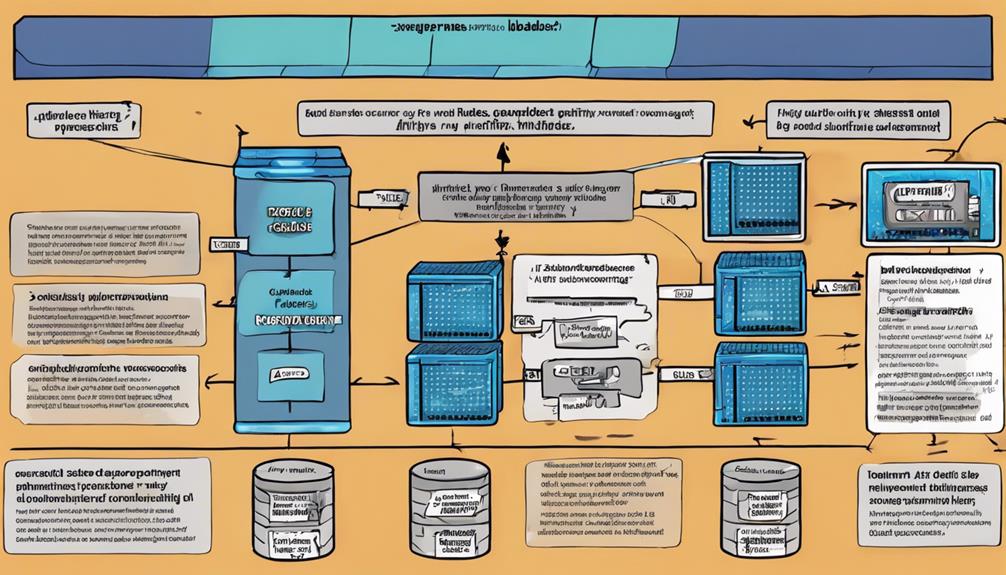You can elevate your Kubernetes deployments with groundbreaking strategies for optimum scaling and performance. Implement horizontal pod auto-scaling and cluster auto-scaling for resource efficiency. Secure your deployment with RBAC permissions and encrypted secrets. Prioritize high availability with pod redundancy and fault-tolerant setups. Optimize performance through resource monitoring and auto-scaling features. Explore multi-cluster deployments for enhanced scalability and fault tolerance. Discover the benefits of multi-cluster deployment versatility. Explore various multi-cluster application architectures for operational excellence. Find out how top deployments are scaling to new heights with these advanced practices.
Key Takeaways
- Utilize multi-cluster configurations for scalability and fault tolerance.
- Implement horizontal pod auto-scaling for efficient resource allocation.
- Employ cluster auto-scaling to meet expanding demands seamlessly.
- Ensure high availability with redundant nodes and self-healing mechanisms.
- Monitor performance and optimize resources for peak efficiency.
Scalability Strategies for Kubernetes Deployments
To efficiently scale Kubernetes deployments, leveraging strategies like horizontal pod auto-scaling (HPA) and cluster auto-scaling is essential. These methods play an important role in optimizing resource utilization and ensuring that large-scale deployments run smoothly.
By dynamically adjusting the number of pods based on resource usage with HPA and automatically provisioning or decommissioning nodes with cluster auto-scaling, Kubernetes can effectively meet the demands of expanding environments without unnecessary waste or strain on resources.
In large-scale deployments, where thousands of nodes and millions of containers are commonplace, these scalability strategies become vital. Companies like Google, Uber, and Twitter have demonstrated the effectiveness of such approaches in managing their extensive Kubernetes setups.
Additionally, the adoption of multi-cluster configurations further enhances scalability by improving availability, isolation, and overall system performance.
Successfully scaling Kubernetes deployments necessitates a keen focus on workload distribution, real-time monitoring, and efficient resource management. By implementing these best practices, organizations can navigate the complexities of scaling Kubernetes with confidence and effectiveness.
Security Measures for Kubernetes Deployment

You should prioritize implementing Role-Based Access Control (RBAC) to restrict unauthorized access, securely managing secrets using tools like Kubernetes Secrets, and employing encryption practices to safeguard sensitive data.
These security measures play an essential role in fortifying your Kubernetes deployment against potential threats and unauthorized activities.
RBAC Implementation
Implementing RBAC in your Kubernetes deployment is important for maintaining secure access control to resources within your cluster. RBAC, which stands for Role-Based Access Control, allows you to define who can access what resources and what actions they can perform. By implementing RBAC, you can enforce security policies and guarantee that only authorized users have the necessary permissions to interact with your Kubernetes cluster.
RBAC provides fine-grained control over user permissions, enabling organizations to limit potential vulnerabilities and protect sensitive data. Roles can be assigned at different levels such as cluster-wide, namespace-specific, or even down to individual resources, allowing for granular access control. This flexibility ensures that you can tailor access permissions to meet the specific security requirements of your deployment.
Incorporating RBAC into your Kubernetes security best practices is vital for safeguarding your cluster and maintaining the integrity of your resources. By implementing RBAC effectively, you can enhance the overall security posture of your Kubernetes deployment.
Secure Secrets Management
Ensuring secure secrets management in your Kubernetes deployment is essential for protecting sensitive information and maintaining data integrity within your containerized applications. In Kubernetes, secrets management involves securely storing sensitive data such as passwords and API keys.
By implementing Kubernetes secrets, you can encrypt this information at rest and in transit, enhancing the overall security of your deployment. These secrets are stored as base64 encoded strings and can be easily mounted as volumes in pods, ensuring that only authorized applications can access them.
Utilizing Role-Based Access Control (RBAC) policies in Kubernetes is vital for controlling access to secrets, guaranteeing that only designated users can retrieve confidential information.
Encryption Practices
Encrypting data at rest and in transit is a critical security measure for safeguarding your Kubernetes deployment. By implementing encryption practices such as utilizing Kubernetes secrets, TLS encryption, and encrypting API server communication, you can enhance the overall security of your cluster. Kubernetes secrets provide a secure way to store sensitive information within the cluster, ensuring that only authorized applications can access them. TLS encryption plays a pivotal role in securing communication between pods and services, preventing unauthorized access to data in transit. Additionally, encrypting Kubernetes API server communication adds an additional layer of protection to safeguard sensitive data and credentials.
| Encryption Practices | Benefits |
|---|---|
| Kubernetes secrets | Secure storage of sensitive information within the cluster |
| TLS encryption | Secure communication between pods and services |
| Encrypting API server communication | Protection of sensitive data and credentials |
Implementing encryption plugins like KMS or Vault can further assist in managing encryption keys and secrets effectively within your Kubernetes environment.
Ensuring High Availability in Kubernetes

To guarantee uninterrupted service availability and reliability in Kubernetes, high availability is an important factor. Kubernetes achieves high availability through features like pod replicas, node redundancy, and self-healing mechanisms.
Meeting scalability requirements involves implementing multi-zone deployments and fault-tolerant architectures to enhance high availability. Load balancing plays a vital role in distributing traffic evenly across pods, making sure no single pod is overwhelmed.
Additionally, health checks continuously monitor the status of pods and automatically replace any unhealthy instances, contributing to maintaining high availability in Kubernetes clusters.
Auto-scaling is another essential aspect that adjusts resources based on demand, preventing performance bottlenecks during peak usage. Monitoring tools like Prometheus and Grafana provide real-time insights into cluster health and performance, enabling proactive measures to maintain high availability.
Performance Optimization Tips for Kubernetes

Maintain peak efficiency in your Kubernetes cluster by implementing key enhancement strategies, including monitoring resource utilization and utilizing horizontal pod auto-scalers for efficient resource allocation.
By keeping a close eye on CPU usage and conducting regular performance analyses, you can guarantee that your Kubernetes deployments are running smoothly.
Horizontal scaling through the use of horizontal pod auto-scalers allows you to dynamically adjust the number of pods based on CPU usage, optimizing resource allocation as workload demands fluctuate.
Additionally, implementing vertical scaling by adding nodes with higher resources such as CPUs and memory can greatly improve Kubernetes performance.
Autoscaling capabilities enable the cluster to automatically adjust the number of nodes based on workload demands, ensuring best resource utilization.
Prioritizing best practices in Kubernetes deployment is essential for enhancing performance and ensuring effective resource management in your environment.
Multi-Cluster Deployment Overview

Enhance your Kubernetes environment by exploring the benefits of multi-cluster deployments for improved availability and scalability.
Multi-cluster deployment involves utilizing multiple Kubernetes clusters, strategically distributed to enhance availability and scalability. In such setups, traffic routing plays an essential role, managed efficiently through global load balancers or API gateways to guarantee ideal load distribution across clusters. These clusters can be spread regionally, across different cloud providers, or at the edge, catering to diverse use cases while providing enhanced scalability.
To facilitate seamless communication between clusters, service meshes are utilized to ensure smooth data exchange and operational efficiency.
Multi-cluster deployments offer numerous advantages, including improved fault tolerance, operational readiness, vendor lock-in elimination, isolation, and compliance benefits. By embracing multi-cluster deployments, organizations can't only enhance their availability and scalability but also establish a robust infrastructure capable of handling varying workloads and traffic demands effectively.
Benefits of Multi-Cluster Deployment

In exploring the benefits of multi-cluster deployment, you gain significant advantages in fault tolerance and scalability for your Kubernetes environment. By distributing workloads across multiple clusters, scalability limits are surpassed, enabling you to efficiently handle increased demands without compromising performance. Additionally, geographic isolation plays an important role in enhancing availability and reducing the impact of regional outages. This guarantees that your applications remain accessible even in the face of localized disruptions. Furthermore, multi-cluster deployments offer improved fault tolerance by eliminating single points of failure, enhancing the overall resilience of your system. To further highlight the benefits of multi-cluster deployment, consider the table below:
| Benefits | Description |
|---|---|
| Improved Fault Tolerance | Avoids single points of failure across multiple clusters, ensuring high system reliability. |
| Enhanced Scalability | Overcomes scalability limits by distributing workloads, enabling seamless handling of increased demands. |
| Geographic Isolation | Enhances availability and mitigates the impact of regional outages, ensuring continuous operation. |
Multi-Cluster Application Architectures

Running different components of an application in separate clusters for improved scalability and fault tolerance characterizes multi-cluster application architectures. Multi-cluster setups often employ a replicated architecture, which entails running identical copies of the application in each cluster. This approach enhances availability and simplifies deployment processes.
Alternatively, the split-by-service architecture in multi-cluster applications allows specific application components to run in dedicated clusters, offering better resource management and isolation. By leveraging multi-cluster deployments, operational readiness is achieved through the elimination of single points of failure and the assurance of high availability across geographically dispersed clusters.
The decision between replicated and split-by-service architectures hinges on various factors such as data synchronization requirements, resource constraints, and deployment complexity in multi-cluster setups. Ultimately, the goal of multi-cluster application architectures is to enable efficient scaling and maintain high availability for complex applications.
Frequently Asked Questions
What Is the World's Largest Kubernetes Cluster?
The world's largest Kubernetes cluster, operated by Pokémon GO, manages over 6,000 nodes spread across multiple regions. It supports millions of daily active users and massive real-time data, showcasing Kubernetes' scalability and reliability.
Which Are Enabled by Kubernetes for the Containers at Large Scale?
Kubernetes enables containers to scale efficiently at large scale by supporting horizontal scaling, self-healing mechanisms, rolling updates, and rollbacks. You can dynamically add or remove containers based on resource demands for improved reliability and management.
What Is the Size Limit for Kubernetes Deployment?
Kubernetes supports up to 5,000 nodes per cluster and 150,000 pods, with Google's GKE allowing up to 15,000 nodes. Large-scale deployments like Spotify run thousands of nodes. Proper planning enables Kubernetes to handle massive workloads.
How Much Overhead Does Kubernetes Add?
Kubernetes typically adds 10-30% overhead in CPU and memory usage. This can increase with additional features like monitoring and logging. Manage overhead through proper resource allocation and optimization. Understanding and monitoring are key for efficient management.
How Can Kubernetes Deployments Contribute to Transforming IT Infrastructure?
Kubernetes deployments play a crucial role in transforming it infrastructure with virtualization. By automating the deployment, scaling, and management of containerized applications, Kubernetes streamlines operations, improves resource utilization, and accelerates innovation. This transformative technology offers a more efficient, flexible, and cost-effective approach to managing IT infrastructure.
Conclusion
Congratulations on learning about the latest trends in Kubernetes deployments!
With scalability strategies, security measures, high availability, performance optimization, and multi-cluster deployment, you're ready to take your applications to new heights.
Just like a well-oiled machine, your Kubernetes deployments will soar to success, seamlessly handling any challenges that come your way.
Keep pushing the boundaries and embracing innovation in your journey to greatness.









